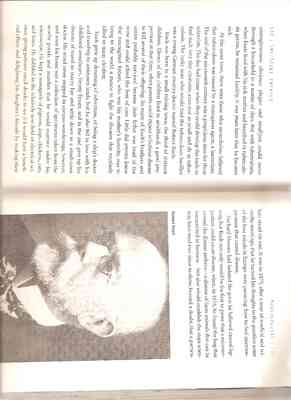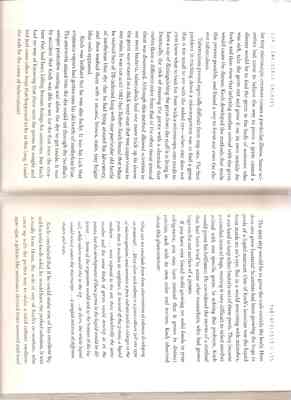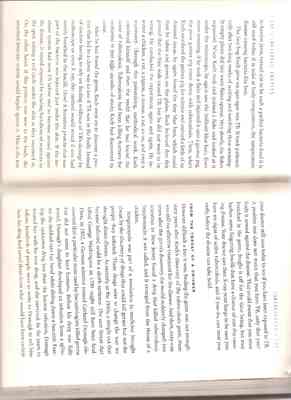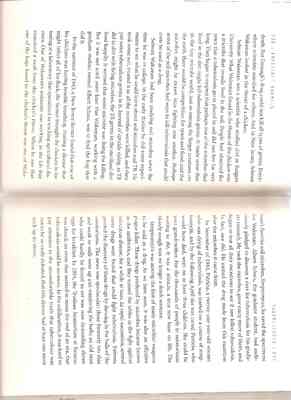Pages
11
At the White Haven tuberculosis sanatorium in Pennsylvania, treatment consisted of one large meal daily plus all the milk and raw eggs one could eat and plenty of fresh air, no matter what the weather. On the day this photograph was taken in 1904, it was 16 degrees below zero. told Madonna he didn't think she would live three more months. Frail, dying, twenty-two-year-old Madonna determined that if she was to die, she would die at home. Then she plotted her escape. With the help of a nurse she had become friendly with and her fellow patients, Madonna sneaked out of the Sioux San alive. Madonna's parents, determined to save their daughter, went to the office of the governor of South Dakota in person to request that she be allowed into the "white" sanatorium. So it was that after six years of the Sioux San, Madonna was admitted to a different hospital with better food and the best treatments available. First her lung was collapsed, in hopes of suffocating the germs. Then all her ribs on one side were removed: since she could hardly breathe, the bugs would get less oxygen. Once drugs that could kill tuberculosis were discovered, such treatments as these were abandoned - and as we look back, it is hard to imagine that they did any good - but at the time, with no other alternatives, doctors would try just about anything. Somehow, becaus of or despite these treatments, Madonna recovered. As prisonlike as the Pines might have been for Betty MacDonald, as painful as Madonna Swan found her treatments, these two were considered among the luck ones: they got into sanatoriums. Around the world, when sanatorium care was all the rage, there were not nearly enough sanatoriums for patients. In 1905 there were three times as many people on the waiting list at a Philadelphia sanatorium as there were beds. In India, by 1935, there was room in sanatoriums for only six thousand of the country's two and a half million patients. Even worse, it was not clear that sanatorium treatment, the only kind available, was doing any good. Some better treatment was clearly needed, and soon. BRILLIANT BLUE RODS The first step to finding a treatment was to discover what caused the disease. That was no easy task. The slow-growing tuberculosis bug hid from scientists very well for so long because Mycobacterium tuberculosis has many tricks up its sleeve. First of all, it infects many different parts of the body. No one would suspect that a person with a swollen festering neck, one with a bloody cough, and one with a crooked spine were all suffering from the same disease. Even after a few brilliant doctors - Laennec was one - saw through this ploy and began to suspect the germ was the same in all these cases, they still had to find it. To make things even more difficult, some of the best minds in science were convinced that tuberculosis was not caused by a germ at all. Because it took years for infected people to show signs of illness, it was hard to connect the disease to exposure to a germ. A quick-moving disease such as plague or smallpox makes it
12
contagiousness obvious: plague and smallpox could move through a household in a matter of days. But with tuberculosis, when Keats lived with his sick mother and breathed in tuberculosis germs, he remained healthy. It was years late that he became sick. At the same time, there were those who nevertheless believed that tuberculosis was caused by a contagious agent, a bacterium. The end of the nineteenth century was a propituous time for these scientists. The day had come when they could develop the tools to find such very tiny creatures, even one as small and sly as tuberculosis. The lucky man who would find the tuberculosis bacillus was a young German country doctor named Robert Koch. Koch was born in a small mining town, the third of thirteen children. Elevn of the children lived to adulthood, a good proportion at the time, when parents could expect infectious disease to kill several of their offspring. So many of Koch's brothers and sisters probably survived because their father ws head of the mine and could afford the best of care. Little did anyone know that nearsighted Robert, who was his mother's favorite, was to bring to the world a means to fight the diseases that routinely killed so many children. Koch grew up dreaming of adventure, of being a ship's doctor and traveling to unknown lands, but he also fell in love with his childhood sweetheart, Emmy Fraatz, and in teh end gave up his dreams of travel to marry her and settle down as a small-town doctor. His mine never stopped its curious wanderings, however, and soon his home was a collection of specimens taken form the nearby ponds and marshes that he would examine under his microscope. He kept a menagerie of pigeons, dogs, chickens, cats, and foxes. He dabbled in the relatively new field of electrical science, giving patients small shocks to see if i would have a beneficial effect, and delighting his daughter's friends by making their hair stand on end. It was in 1875, after a tour of medical and scientific meetins, that he turned his thoughts to the question some of the best minds in Europe were pursuing: how to find microorganisms that caused disease. Gerhard Hansen had isolated the germ he believed caused leprosy, but Koch not only would be the first to prove that a microorganism could cause disease, when, in 1876, he found the bug that caused the disease anthrax - a disease of farm animals that can be transmitted to humans - but also would establish the steps scientists have used ever since to show, beyond a doubt, that particu-
13
lar tiny microscopic creature causes a particular illness. Some scientists had come to believe the way to prove a germ caused a disease would be to find the germ in the body of someone who was sick, take the germ out and grow it on its own outside the body, and then show that infecting another animal with the germ would cause the disease. Koch developed the methods that made this process possible, and found a way to ferret out even the elusive tuberculosis. Tuberculosis proved especially difficult from step one. The first problem in tracking down a microorganism was to find a germ that is too small to see with the naked eye - when one does not even know what to look for. Even with a microscope, one needs to have a way of distinguishing the germ from the stuff it is living in. Eventually, the trick of staining the germs with a chemical that makes them a different color from that of the other tissue around them was discovered. Although this method allowed scientists to see most bacteria, tuberculosis had one more trick up its sleeve: the germ was encased in a thick waxy coat that was impervious to any stain. It was not until 1882 that Robert Koch found that when he stained bits of TB-infected lung with one particular old bottle of methylene blue dye that he had lying around his laboratory, and then washed them with a second, brown, stain, tiny bright blue rods appeared. Koch was brilliant but he was also lucky. It was his luck that ammonia vapors had gotten into his old bottle of methylene blue. The ammonia mixed into the dye could eat through the bacillus's unique protective coating and allow the dye to get inside. It was by accident that Koch was able to see for the first time the creature that had been killing human beings for centuries. But Koch had no way of knowing that these were the germs he sought and not just some other bugs that happened to be in this lung. Could the rods be the cause of tuberculosis? The next step would be to grow the rods outside the body. How does one grow bacteria? Scientists had been growing the bugs in pools of a liquid nutrient. One of Koch's favorites was the liquid from inside an ox's eye. But in a world swarming with microbes, it was hard to keep other bacteria out of these pools. They became a crowded mess of bugs, making it very difficult to infect another animal with one specific germ. In solving this problem, Koch would prove his brilliance. He considered the merits of a method that had been tried by some other researchers, who had grown bugs on the cut surface of a potato. If you have ever found mold growing on solid foods in your refrigerator, you may have noticed that it grows in distinct patches, each with its own color and texture. Koch observed about this phenomenon: What can we conclude from these observations of colonies developing on potatoes?...Most often each colony is a pure culture [all one type of microorganism] and remains a pure culture until it enlarges to the point that it touches its neighbors. If instead of the potato, a liquid medium....were exposed to the air, then undoubtedly the same number and the same kinds of germs would develop as on the potato, but the development of these germs in the liquid would be different...Some of the organisms would sink to the bottom of the liquid, while others would rise to the top...In short, the whole liquid would reveal under the microscope...a tangled mixture of different shapes and sizes. Koch concluded that if he could make one of his excellent liquid bacteria foods solid, he would have the perfect solution. It was actually Frau Hesse, the wife of one of Koch's co-workers, who came up with the perfect way to make a solid culture medium: agar-agar, a gelatin-like substance derived from seaweed and used
14
to harden jams, turned out to be such a perfect bacteria food it is still used today. It is solid at body temperature, the temperature disease-causing bacteria like best. The first bug Koch grew on agar-agar was TB. It took patience
15
death. But Domagk's drug could not kill all types of germs. Everywhere scientists searched for others. And in New Jersey, Selman Waksman looked in the throat of a chicken. Selman Waksman was a scientist who studied dirt at Rutgers University. What Waksman found in the throat of the chicken was a microbe that usually lived in the soil. People had observed for years that a tuberculosis germ placed in soil did not live for very long. They began to suspect that perhaps one of the microbes that lived in the soil. People had observed for years that a tuberculosis germ placed in soil did not live for very long. They began to suspect that perhaps one of the microbes that lived in the dirt might kill tuberculosis germs. It made sense that in the tiny microbe world, just as among the larger creatures on the earth, there would be competition for space and food, and the microbes might be drawn into fightin one another. Perhaps some of the soil microbes had ways to kill tuberculosis that could even be used as a drug. Selman Waksman had been studying soil microbes since the time he was in college. In the early thirties he did some experiments to see what he could learn about soil microbes and TB. He took some soil, treated it so all the microbes were killed, and then put some tuberculosis germs in it. Instead of quickly dying, as TB did in dirt with living microbes, the TB germs in the sterilized dirt lived happily. It seemed that some microbe was doing the killing. But it was not until years later that Waksman, working with a graduate student named Albert Schatz, was to find the bug that did it. In the summer of 1943, a New Jersey farmer found that one of his chickens was having trouble breathing. Fearing a disease that might infect all his flock, the farmer brough the chicken in for testing at a laboratory that specialized in tracking agricultural diseases. One of Wakman's assistants was working in the lab that examined a swab from this chicken's throat. When he saw that one of the bugs found in the chicken's throat was on of Waksman's favorite soil microbes, Streptomyces, he saved the specimens for Waksman. Albert Schatz, the graduate student, had audaciously pledged to discover a cure for tuberculosis for his graduate research. He took the microbes, grew many more of them, and began to test all their excretions to see if one killed tuberculosis. In fact, one did. He name the drug made from this excretion after the microbes it came from. In November of 1944, Patricia, a twenty-one year old woman who was dying of tuberculosis, was started on a course of stretomycin, and by the following April she was cured. Patricia, who would have died, went on to have three children. She could be your grandmother. For the thousands of people in sanatoriums waiting to die, it was a miracle, a true new lease on life. The bloody cough was no longer a death sentence. Streptomycin was among the first of many microbial weapons to be sold as a drug. As we have seen, it was also an effective plague killer. These drugs produced by microbes became known as the antibiotics, and they turned the tables in the fight against infectious disease, for a while at least. In rapid succession, several more drugs were found that could fight tuberculosis. Patients greeted the discovery of these drugs by dancing in teh halls of the sanatoriums. The news was spectacular: those formerly too thin and weak to walk were up and wandering the halls; an old man who could hardly be forced to eat was now demanding eleven eggs for breakfast. In 1954, the Trudeau Sanatorium at Saranac was closed, an event that seemed to mean the end of an era, that tuberculosis would be no more. In the exhiliration, it was hard to pay attention to the uncomfortable truth that tuberculosis was not to be so easily defeated, that this disease had at least one more trick up its sleeve.




